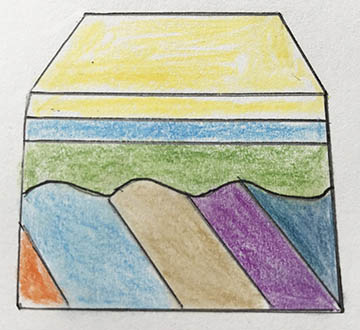An unconformity is a surface between a group of sedimentary beds (layers, strata) and the underlying rocks; it is an ancient land surface that represents an interval of time during which erosion occurred rather than deposition. In geologic cross-sections, unconformities are represented traditionally by a wavy line or a jagged line.
There are three kinds of unconformities: 1) disconformity, 2) angular unconformity, and 3) nonconformity.
In the sketched diagrams below, the different rock layers are in various colors or symbols.
1) DISCONFORMITY:
A disconformity forms when erosion removes certain layer(s) of sediment, and all the remaining layers are horizontal. The disconformity is depicted by a wavy line.
2) ANGULAR UNCONFORMITY:
An angular unconformity forms when a group of rocks have been tilted and removed (eroded) to some degree, and younger rocks have been deposited on top of them; (the eroded surface is an angular unconformity). In the box diagram below, the angular unconformity is depicted by a wavy line.
3) NONCONFORMITY:
A nonconformity forms when an erosion event occurs on crystalline rocks (i.e., igneous and/or metamorphic rocks), and the overlying layers of sedimentary rock are horizontal (note: they can later be tilted). In the box diagram below, the nonconformity is represented by the jagged line below the colored layers of sedimentary rock; and the igneous and/or metamorphic rocks are depicted by the short, straight dashes.
Examples in the Grand Canyon of the Three Types of Unconformities:
The Grand Canyon in northern Arizona has classic examples of all three types of unconformities, as depicted in my geologic cross section shown below. My commentary on the associated geologic history events accompanies this cross section.
Much of the information in this figure is derived from a geologic cross section published in 1971 by the Zion Natural History Association. Additional detail is derived from Wikipedia (2022).The following two photographs were taken by the author in the late 1960s.
A widespread angular unconformity occurs between tilted Precambrian sedimentary beds (in the foreground of the photo) and the overlying non-tilted younger Cambrian strata (in the middle of the photo). The view is toward the north side of the Grand Canyon. This angular unconformity in the Grand Canyon is also generally known as “Powell’s Great Unconformity,” in reference to John Wesley Powell, an American geologist who explored the Colorado River and its canyons via two raft trips (1869 and 1871). John Newberry was the first to detect a similar erosion surface in Precambrian rocks in New Mexico during the Ives Expedition of 1857-1858, but disruption by the American Civil War kept Newberry’s work from becoming widely known.
This photo shows another type of unconformity in the Grand Canyon and is actually the oldest unconformity (Precambrian in age) found there. It is a nonconformity that is only exposed locally by down-cutting of the Colorado River, in one of the deepest parts of the Grand Canyon, between the black underlying metamorphic Vishnu Schist, so-called "basement rock," and the overlying brown sedimentary layers.
References:
Stanley, S.M. 1999. Earth System History, W.H. Freeman & Co., New York, pp. 10-11.
Wikipedia (website). 2022. The Great Unconformity.
Zion Natural History Association, 1971. Geologic cross section of the Cedar Breaks-Zion-Grand Canyon region, Zion Natural History Association, Zion Natural Park, Springdale, Utah.






No comments:
Post a Comment